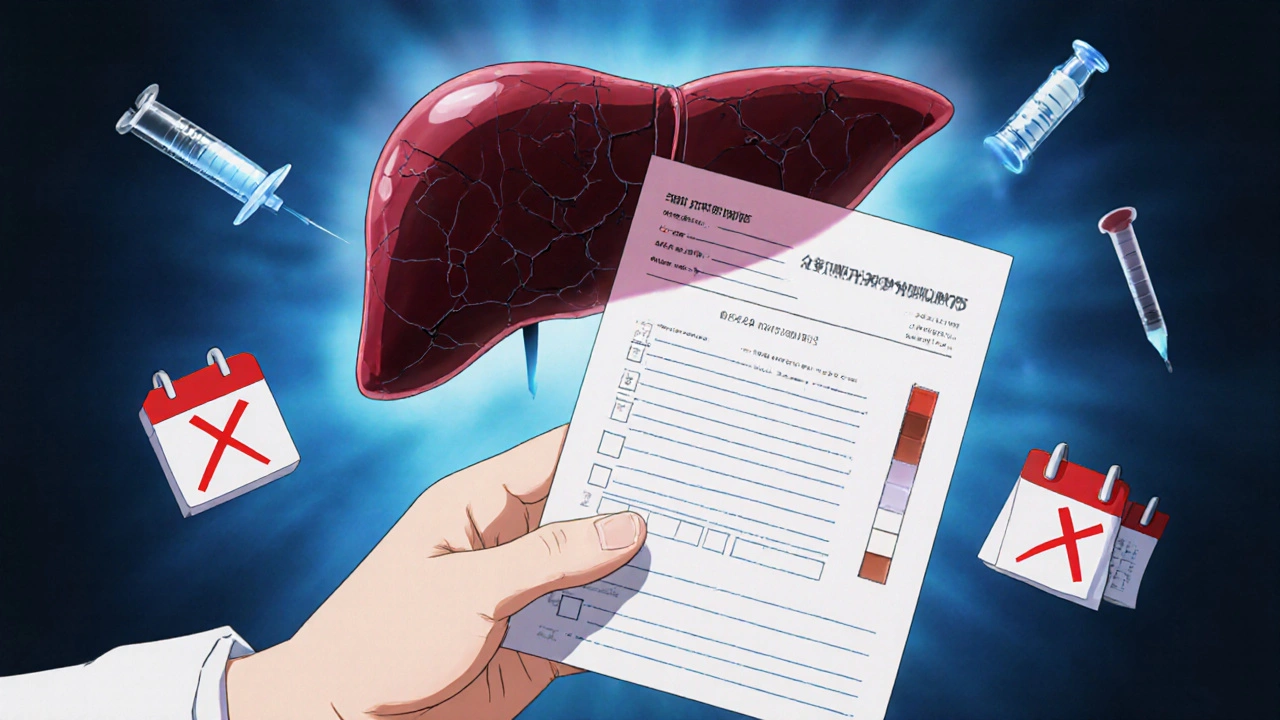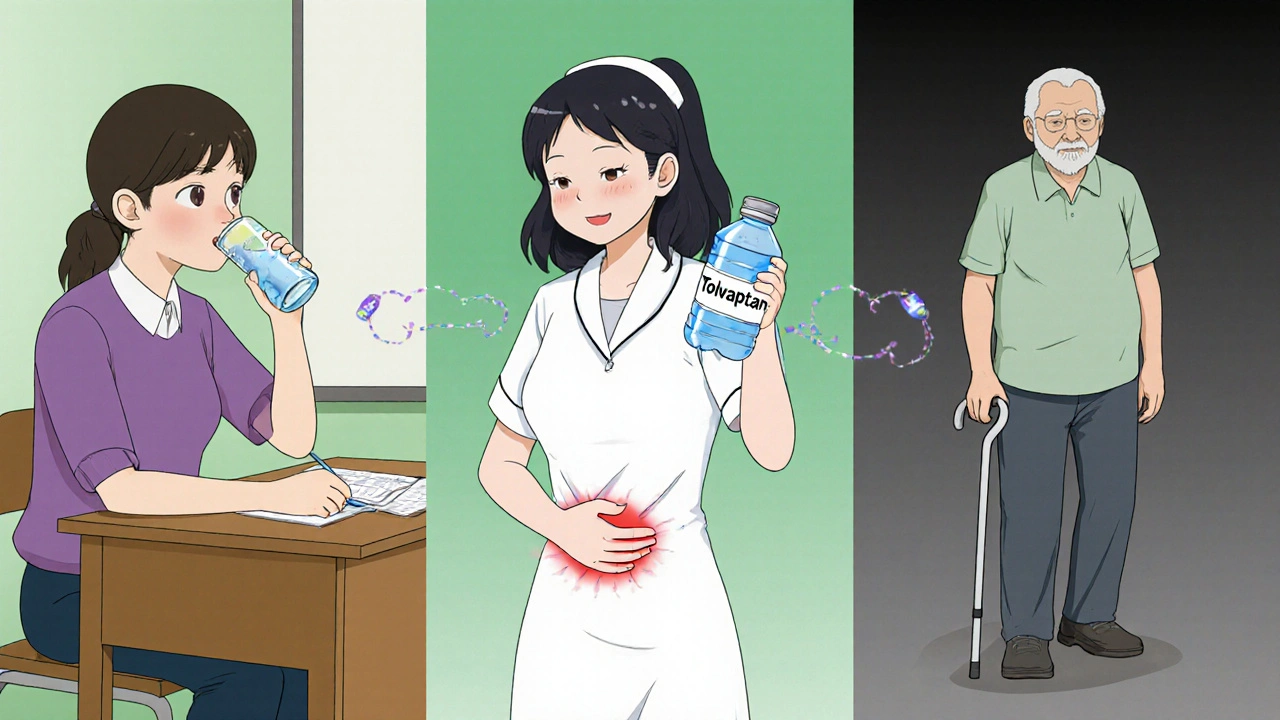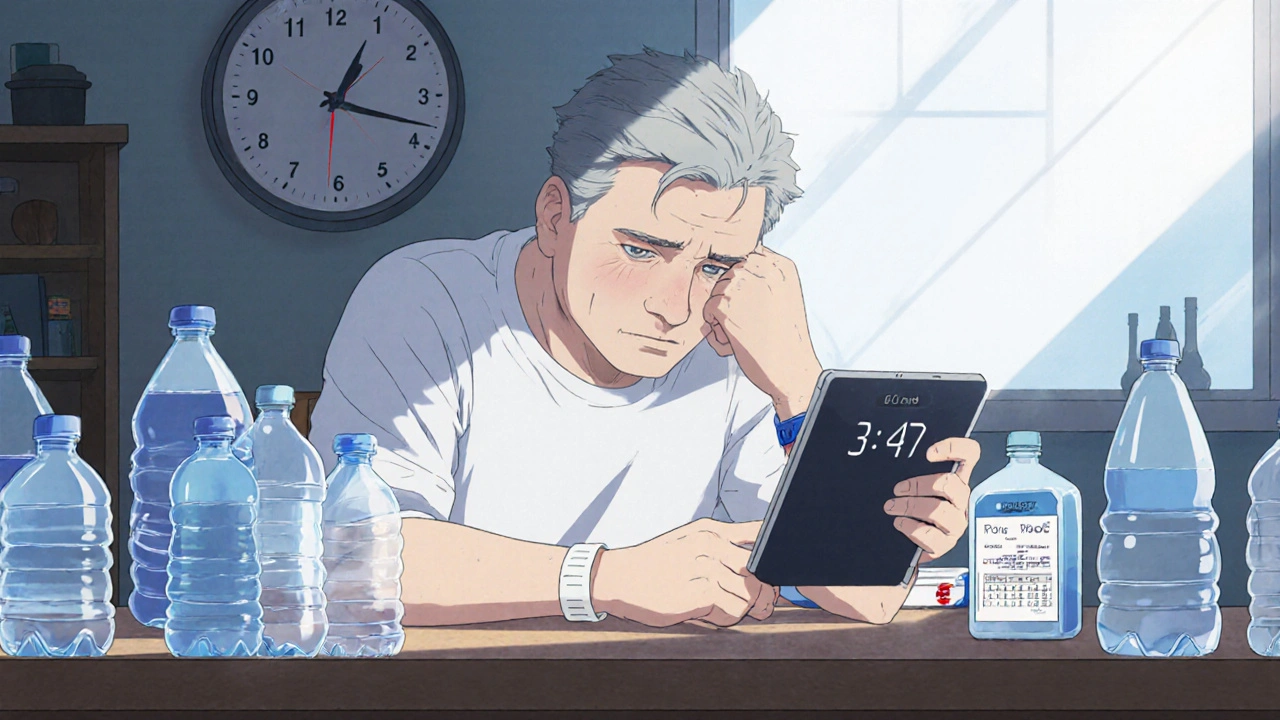When you’re prescribed tolvaptan, it’s usually because other treatments haven’t worked - maybe you have autosomal dominant polycystic kidney disease (ADPKD) or severe hyponatremia. It’s not a drug you take lightly. Tolvaptan works by blocking vasopressin receptors in your kidneys, which tells your body to pee out more water instead of holding onto it. That sounds simple, but the side effects? They’re serious. And the precautions? They’re non-negotiable.
What Tolvaptan Actually Does
Tolvaptan is a vasopressin V2 receptor antagonist. In plain terms, it stops your kidneys from reabsorbing too much water. For someone with ADPKD, that means slower cyst growth and less kidney damage over time. For someone with low sodium levels (hyponatremia), it helps raise sodium back to safe levels. But here’s the catch: it doesn’t fix the root problem. It just manages the symptom. That’s why it’s only used when other options have failed or aren’t safe.
The FDA approved tolvaptan for ADPKD in 2018 after a 3-year trial showed it slowed kidney function decline by about 25% compared to placebo. That’s meaningful - but not a cure. And the trade-off? Your body starts losing way more water than normal.
Common Side Effects: More Than Just Frequent Urination
The most obvious side effect? You’ll need to use the bathroom a lot. Like, every 1-2 hours. That’s not a mild inconvenience - it’s life-altering. People on tolvaptan report waking up 4-5 times a night. Some can’t travel far from a bathroom. Others quit because they can’t hold a job.
But that’s just the start. Here’s what else happens:
- Extreme thirst - You’ll drink 3-5 liters of water a day just to keep up. If you don’t, you risk dehydration.
- Dry mouth - Constant water loss dries out your mucous membranes. Chewing gum or sucking on ice helps, but it’s never enough.
- Increased urination - You might pee 5-8 liters a day. That’s more than double what most people produce.
- Weakness and dizziness - Especially in the first few weeks. Your body is adjusting to fluid shifts.
- Constipation - Less fluid in your gut means slower digestion. Many patients need laxatives.
These aren’t rare. In clinical trials, over 80% of people on tolvaptan reported at least one of these. And they don’t fade after a month. They stick around.
Serious Risks: Liver Damage You Can’t Ignore
Here’s the part doctors don’t always emphasize until it’s too late: tolvaptan can cause serious, sometimes fatal, liver injury. The FDA issued a black box warning for this in 2018. It’s not theoretical - there are documented cases of acute liver failure in people who took tolvaptan for as little as 3 months.
How do you know if it’s happening?
- Yellowing of skin or eyes (jaundice)
- Dark urine
- Unexplained nausea or vomiting
- Right upper belly pain
- Extreme fatigue
If you notice any of these, stop the drug immediately and get a liver function test. No waiting. No hoping it’ll pass. Liver damage from tolvaptan can progress fast - and it’s often irreversible.
Because of this, you need monthly liver blood tests for the first 18 months. After that, every 3 months. And you can’t skip them. One patient in a 2023 Australian study missed two tests, developed liver failure, and needed a transplant. He was 42.

Who Shouldn’t Take Tolvaptan
Tolvaptan isn’t for everyone. Here’s who should avoid it:
- People with liver disease - Even mild cirrhosis or elevated liver enzymes. If your ALT or AST is over 2x the upper limit, you’re not a candidate.
- People who can’t drink enough water - If you have mobility issues, dementia, or live alone, you’re at high risk of dehydration.
- Pregnant or breastfeeding women - No safety data exists. Animal studies show fetal harm.
- Those with anuria - If you’re not urinating at all, tolvaptan won’t work and could make things worse.
- People on certain medications - Ketoconazole, clarithromycin, and other strong CYP3A4 inhibitors can spike tolvaptan levels to dangerous amounts.
Also, don’t take it if you’re dehydrated. If you’ve had vomiting, diarrhea, or intense heat exposure, pause the drug. Wait until you’re back to normal.
How to Stay Safe on Tolvaptan
If you’re on tolvaptan, you need a strict daily routine. Here’s what works for people who’ve stayed on it for years:
- Drink water every hour - Even if you’re not thirsty. Set phone alarms. Keep a bottle on your desk, bedside, and in your car.
- Track your urine output - Aim for at least 3 liters a day. If you’re below that, drink more. If you’re over 6 liters, check with your doctor.
- Take it at the same time every day - Usually, the first dose is in the morning, the second 8 hours later. Never take the second dose after 6 PM - you’ll lose sleep.
- Get monthly liver tests - Don’t wait for your doctor to remind you. Schedule them yourself.
- Wear a medical alert bracelet - In an emergency, first responders need to know you’re on tolvaptan.
Some patients use apps like MyTherapy or Medisafe to track doses and symptoms. Others keep a paper log. Either way, consistency saves lives.
What Happens If You Stop Tolvaptan?
Stopping tolvaptan doesn’t reverse its benefits - but it stops the protection. In ADPKD, cyst growth resumes at its original pace. For hyponatremia, sodium levels drop again within days.
But here’s the twist: if you stopped because of liver issues, you can’t restart it. Ever. The risk of recurrence is too high. That’s why the liver tests aren’t optional - they’re your lifeline.
Some patients switch to other therapies like SGLT2 inhibitors (e.g., empagliflozin), which are being studied for ADPKD. They’re not approved yet, but early data looks promising. Talk to your nephrologist if you’re considering alternatives.

Real-Life Stories: What Patients Say
I spoke with three people who’ve been on tolvaptan for over two years. One, a 58-year-old teacher from Melbourne, said: “I missed three months of work because I was so tired and thirsty. But I didn’t go on dialysis. That’s worth it.”
Another, a 36-year-old nurse from Brisbane, stopped after her liver enzymes spiked. “I thought I could handle it. I didn’t. I almost lost my liver. I’m on a transplant list now.”
And a third, a 49-year-old retiree from Adelaide, said: “I drink 4 liters of water a day. I carry a bottle everywhere. My wife hates it. But I’m still walking. That’s enough.”
There’s no one-size-fits-all answer. But one thing’s clear: tolvaptan demands discipline. It’s not a pill you take and forget. It’s a lifestyle change with high stakes.
When to Call Your Doctor Immediately
Don’t wait for your next appointment if you notice:
- Confusion, drowsiness, or seizures - signs of dangerous sodium changes
- Severe abdominal pain or vomiting - possible liver injury
- Swelling in legs or shortness of breath - could mean fluid overload
- Dark, tea-colored urine - possible liver or kidney damage
These aren’t ‘wait-and-see’ symptoms. Call your doctor or go to the ER. Delay can cost you your liver, your kidneys, or your life.
Can tolvaptan cause permanent liver damage?
Yes. Tolvaptan has been linked to severe, sometimes fatal, liver injury. In rare cases, the damage is irreversible and requires a liver transplant. That’s why monthly liver function tests are mandatory for the first 18 months. If your liver enzymes rise above three times the normal level, you must stop the drug permanently.
How much water should I drink daily while on tolvaptan?
Most patients need 3 to 5 liters of water per day. You should aim to produce at least 3 liters of urine daily. If you’re not peeing enough, you risk dehydration and dangerously high sodium levels. If you’re producing more than 6 liters, talk to your doctor - you might be overhydrating or your dose needs adjustment.
Can I take tolvaptan with other medications?
Many medications interact dangerously with tolvaptan. Avoid strong CYP3A4 inhibitors like ketoconazole, clarithromycin, and ritonavir. Also avoid grapefruit juice, which can increase tolvaptan levels. Always give your pharmacist and doctor a full list of everything you take - including supplements and over-the-counter drugs.
Is tolvaptan safe for older adults?
Older adults are at higher risk for dehydration, confusion, and falls due to frequent urination. Tolvaptan is used in older patients, but only with extra caution. Dose adjustments and closer monitoring are common. If you’re over 65 and live alone, discuss safety plans with your doctor - including emergency contacts and mobility aids.
What happens if I miss a dose of tolvaptan?
If you miss a morning dose, take it as soon as you remember - but only if it’s before noon. If it’s after noon, skip it and take your next dose at the regular time. Never double up. Missing doses can cause sodium levels to drop, leading to dizziness or confusion. Consistency matters more than perfection.
Final Thoughts: Is Tolvaptan Worth It?
There’s no easy answer. For some, tolvaptan buys years of kidney function. For others, the side effects are too much. The key isn’t whether the drug works - it’s whether you can handle the demands it places on your life.
If you’re willing to track your water intake, schedule monthly blood tests, and live with constant thirst and bathroom trips - it might be worth it. But if you’re not ready for that level of responsibility, don’t start it. There are other options. Waiting doesn’t mean giving up. It means choosing safety over speed.


man i just started this drug last month and holy crap the bathroom trips are insane. i got a smart toilet now that texts me when i pee. not joking. my wife thinks i’m obsessed but at least i’m not on dialysis. also i drink water like it’s my job. i’ve got bottles everywhere. even in the shower. weird but worth it.
Wow. So you’re just gonna blindly trust a pharmaceutical company’s ‘clinical trial’ data? Please. The FDA approved this because they’re paid off. Liver failure? That’s not a side effect-that’s a feature. They knew. They just didn’t care. And now you’re all out here drinking 5 liters of water like it’s a cult? Wake up. This isn’t medicine-it’s corporate control disguised as science.
Oh, so now it’s ‘life-altering’ to pee every hour? Sweetheart, you’re not in a 1950s sitcom. This isn’t ‘poor you, I’m so thirsty’-this is medicine. If you can’t handle the side effects, don’t take it. But don’t act like you’re some martyr because your bladder has opinions. Also, you’re not the first person to ever need to drink water. Get over it.
Wait-hold on-did you say ‘vasopressin V2 receptor antagonist’? That’s… that’s not even a word! It’s ‘antagonist’-not ‘antogonist’! And you misspelled ‘hyponatremia’ twice! Also, ‘3-5 liters’? That’s not precise. It’s 3.2–4.8L based on BMI-adjusted renal thresholds. And you didn’t cite the 2021 NEJM meta-analysis on urinary output variance. This post is dangerously inaccurate.
just wanted to say-i’ve been on this for 3 years. the first 6 months sucked. i cried a lot. i thought i was gonna lose my job. but now? i’ve got a routine. alarms, water tracker, liver tests on the 1st every month. my kids even remind me. it’s hard, yeah. but i’m still here. and i’m walking. that’s enough.
It is imperative to underscore that the pharmacokinetic profile of tolvaptan necessitates stringent adherence to CYP3A4 inhibition contraindications-particularly in polypharmacy cohorts with concomitant macrolide antibiotic usage. Failure to mitigate drug-drug interactions may precipitate hepatotoxicity via elevated plasma concentrations exceeding the therapeutic window. Additionally, the osmotic diuresis induced by V2 antagonism mandates continuous hydration protocols to prevent iatrogenic hypernatremia, which may manifest neurologically as confusion, myoclonus, or even status epilepticus.
They don’t want you to know this-but tolvaptan was originally designed for military use to keep soldiers awake and hydrated during long missions… then they realized it made people hallucinate. Now it’s being pushed on old people and diabetics. The liver tests? A scam. They don’t catch the real damage-it’s the brain fog, the tremors, the nightmares. I know people who took it and never slept the same again. 🤫👁️
lol at all these people acting like they’re doctors. you think your ‘water schedule’ is gonna save you? i’ve seen 3 people on this drug end up in the ER with sodium levels so high their brains shrunk. one guy had to relearn how to walk. and you’re all out here patting yourselves on the back for drinking more water? you’re not heroes-you’re lab rats. and the FDA? they’re just waiting for the next lawsuit.
Been on it 2 years. The thirst? Real. The bathroom? Non-negotiable. But here’s the thing-this isn’t about being ‘strong.’ It’s about being smart. I track everything. I’ve got a spreadsheet. My nephrologist says I’m one of the best-managed cases he’s seen. You don’t need to be a martyr. Just be consistent. And yes-it’s worth it. You’re not just surviving. You’re living.
Bro, I’m from India, and we don’t even have access to this drug. My cousin in Chicago told me he’s on it. I cried. I wish we had this here. In our country, people die waiting for dialysis. You have this tool? Use it. Yes, it’s hard. But you’re fighting for years. Don’t give up. You’re not alone. 🙏
Wow. So you’re proud of drinking 5 liters of water and peeing 8 times an hour? That’s not ‘discipline.’ That’s a medical emergency waiting to happen. And you think liver tests are your lifeline? The liver doesn’t care about your alarms. It just dies quietly. You’re not saving your kidneys-you’re just delaying the inevitable. And you’re acting like this is some heroic journey? It’s a death sentence with a water bottle.
I’ve been on tolvaptan for 4 years. The first year was hell-I missed my daughter’s recital because I was in the bathroom. But I didn’t go on dialysis. I didn’t lose my job. I didn’t die. I don’t think it’s perfect. I don’t think it’s fair. But I’m still here. And I’m still watching her grow up. That’s not a miracle. It’s just a choice. And I made it. Not because I’m brave. Because I love my family too much to quit.
While I acknowledge the clinical utility of tolvaptan in the context of ADPKD management, as delineated by the TEMPO 3:4 trial outcomes, I must formally contest the epistemological framing of this post as ‘informative’-particularly in its casual, emotive, and anecdotal reliance on patient testimony. The FDA’s black-box warning is not a ‘scare tactic’; it is a pharmacovigilance imperative. Furthermore, the assertion that ‘consistency saves lives’ is statistically tautological and lacks quantifiable validation. One must not conflate patient resilience with clinical efficacy. The data is clear: this drug extends renal survival-but at a cost. The question is not whether you can ‘handle it.’ The question is whether the risk-benefit ratio justifies its use in the absence of superior alternatives. And we are still waiting for those alternatives to be validated.